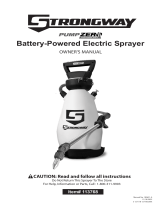
Congratulations!
YouhavejustpurchasedaqualityChapinproduct.
RegisterYourSprayerOnline@www.chapinmfg.com/warranty.asp
Chapin International, Inc
P. O. Box 549 700 Ellicot St. • Batavia, NY 14021-0549 U.S.A. • 1-800-950-4458 • www.chapinmfg.com
Due to our ongoing product improvement process, product specifications may change without notice. U.S. and foreign patents pending.
THIS LIMITED WARRANTY GIVES YOU, THE ORIGINAL PRODUCT PURCHASER, SPECIFIC LEGAL RIGHTS. YOU MAY ALSO HAVE
OTHER RIGHTS, WHICH VARY FROM STATE TO STATE.
SUBJECT TO THE LIMITATIONS SET FORTH BELOW, CHAPIN WARRANTS TO THE ORIGINAL PRODUCT PURCHASER ONLY, THAT THE
PURCHASED PRODUCT WILL BE FREE FROM DEFECTS IN MATERIALS AND WORKMANSHIP FOR A PERIOD OF TWO (2) YEARS
FROM THE DATE OF PURCHASE. THIS LIMITED WARRANTY EXTENDS ONLY TO THE ORIGINAL PURCHASER OF THE PRODUCT.
IT DOES NOT EXTEND TO ANY SUBSEQUENT OWNER OR TRANSFEREE OF THE PRODUCT, OR ANY LESSEES OF THE PRODUCT.
THIS LIMITED WARRANTY DOES NOT COVER ANY DAMAGE OR DEFECT DUE TO OR RESULTING FROM TRANSPORTATION,
STORAGE, IMPROPER USE, FAILURE TO FOLLOW PRODUCT INSTRUCTIONS, FAILURE TO PERFORM RECOMMENDED
PREVENTATIVE MAINTENANCE, MODIFICATIONS, UNAUTHORIZED REPAIR, NORMAL WEAR AND TEAR, OR EXTERNAL CAUSES
SUCH AS ACCIDENTS, ABUSE, MISUSE, ALTERATION OR OTHER ACTIONS OR EVENTS BEYOND OUR REASONABLE CONTROL.
EXCEPT FOR THE EXPRESS LIMITED WARRANTY SET FORTH IN THIS DOCUMENT, WE MAKE NO OTHER WARRANTIES, EXPRESS
OR IMPLIED, INCLUDING, WITHOUT LIMITATION, IMPLIED WARRANTIES OF MERCHANTABILITY AND FITNESS FOR A PARTICULAR
USE OR PURPOSE. SOME STATES DO NOT ALLOW LIMITATIONS ON IMPLIED WARRANTIES, SO THIS LIMITATION MAY NOT APPLY
TO YOU
OUR RESPONSIBILITY FOR A DEFECTIVE PRODUCT IS LIMITED TO REPAIR, REPLACEMENT OR REFUND, AT OUR DISCRETION. THE
WARRANTY PERIOD IS NOT EXTENDED IF WE REPAIR OR REPLACE THE PRODUCT.
WITH RESPECT TO A DEFECT IN THE PRODUCT ARISING DURING THE WARRANTY PERIOED AND WHICH WE ARE NOTIFIED OF
IN WRITING WITHIN THRITY (30) DAYS OF THE EXPIRATION OF THE WARRANTY PERIOD, WE WILL, AT OUR DISCRETION, EITHER
REPAIR OR REPLACE THE PRODUCT OR DEFECTIVE PART FREE OF CHARGE, OR REFUND THE PURCHASE PRICE OF SUCH
PRODUCT. PLEASE NOTE THIS WARRANTY DOES NOT COVER SHIPPING AND HANDLING EXPENSESES TO RETURN A DEFECTIVE,
REPAIRED, OR REPLACEMENT PRODUCT. DO NOT RETURN THE PRODUCT WITHOUT FIRST RECEIVING WRITTEN AUTHORIZATION
FROM US. WE RERSERVE THE RIGHT TO REJECT ANY WARRANTY CLAIM WHICH WE HAVE NOT RECEIVED WRITTEN NOTICE
OF WITHIN THIRTY (30) DAYS OF THE EXPIRATION OF THE WARRANTY PERIOD.
TO OBTAIN WARRANTY SERVICE YOU MUST, DURING OR NOT LATER THAN THIRTY (30) DAYS AFTER THE EXPIRATION OF THE
WARRANTY PERIOD, EITHER CALL US AT 1-800-950-4458, OR EMAIL US AT www.chapinmfg.com IN EACH CASE WITH A
DESCRIPTION OF THE PRODUCT AND DEFECT. YOU MUST ALSO PROVIDE US WITH A SALES RECEIPT OR COMPARIBLE PROOF
OF PURCHASE SHOWING THE ORIGINAL DATE OF PURCHASE BY YOU.
THE REMEDIES DESCRIBED ABOVE ARE YOUR SOLE AND EXCLUSIVE REMEDIES. OUR ENTIRE LIABILITY FOR ANY BREACH OF
THIS LIMITED WARRANTY SHALL UNDER NO CIRCUMSTANCES EXCEED THE ACTUAL AMOUNT PAID BY YOU FOR THE DEFECTIVE
PRODUCT. IN ADDITION, UNDER NO CIRCUMSTANCES SHALL CHAPIN BE LIABLE FOR ANY CONSEQUENTIAL, INCIDENTAL,
SPECIAL OR PUNITIVE DAMAGES OR FOR ANY LOSSES OR LOST PROFITS, WHETHER DIRECT OR INDIRECT AND WHETHER OR
NOT WE WERE INFORMED OF THE POSSIBILITY OF SUCH.
SOME STATES DO NOT ALLOW THE EXCLUSION OR LIMITATION OF INCIDENTAL OR CONSEQUENTIAL DAMAGES, SO THE ABOVE
LIMITATION OR EXCLUSION MAY NOT APPLY TO YOU.
















